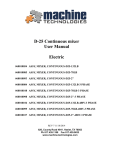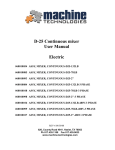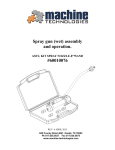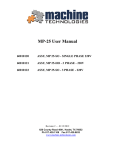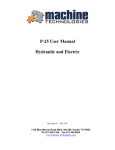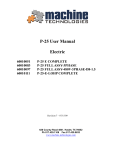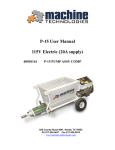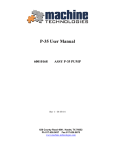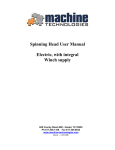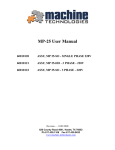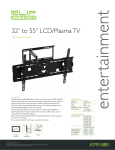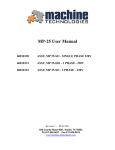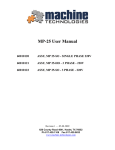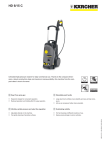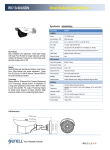Download D-25 Continuous mixer User Manual Electric
Transcript
D-25 Continuous mixer User Manual Electric #60010054 ASSY, MIXER, CONTINUOUS-D25-132LB #60010085 ASSY, MIXER, CONTINUOUS-D25-78LB #60010093 ASSY, MIXER, CONTINUOUS-D25-2" REV-5 10/11/07 1130 Blue Mound Road West, Ste 400. Haslet, TX 76052 Ph 817.439.1108 Fax 817.439.0633 www.machine-technologies.com Dear Customer, Before starting this machine please complete the following; Machine Date of purchase………………………………….. Machine serial number……………………………………… Please read the following information contained within this manual and fully familiarize yourself with the equipment. Page 1 Contents Page Section 1 - General Safety information........................................................................... 3 Danger............................................................................................................................. 3 Section 2 - Machine Description ...................................................................................... 4 Function.......................................................................................................................... 4 Machine illustrations..................................................................................................... 5 Machine ....................................................................................................................... 5 Hopper unit................................................................................................................. 6 Mixing Nozzle Assembly – 132LB shown .................................................................... 7 Assy,Breaker-Dosing-Mix-D25 - 132LB shown........................................................... 8 Dosing / Feed screw - 60010069 - Assy, Helix-Cont Mixer-132lb .......................... 9 Dosing / Feed screw - 60010074 - Assy, Helix-Cont Mixer-78lb ............................ 9 Dosing / Feed screw - 60010088 - ASSY,HELIX-CONT MIXER-2" .................... 9 Wear liner assembly, Seal, Seal clamp, Bolts and Washers ................................. 10 Base Frame assembly ............................................................................................... 11 Drive motor unit....................................................................................................... 13 Water Control Module............................................................................................. 14 Section 3 – Transportation and positioning.................................................................. 15 Section 4 – Machine set up ............................................................................................. 17 Unpacking and assembly............................................................................................. 17 Electrical connections.................................................................................................. 24 Section 5 – Machine operation / speed setting.............................................................. 26 General notes for operation ........................................................................................ 26 Section 6 – Maintenance................................................................................................. 27 Wear parts.................................................................................................................... 27 Maintenance ................................................................................................................. 27 LIMITED WARRANTY POLICY .............................................................................. 28 Page 2 Section 1 - General Safety information Danger Follow these instructions very carefully, in order to avoid injury to yourself or others. Electrically powered machine. Always ensure that all power to the machine has been turned off and isolated before ANY maintenance / repair work is carried out on the machine. Ensure that all guards are correctly fitted before starting or attempting to operate the machine. Ensure that all fasteners are present and correctly fitted before attempting to start or operate the machine. Ensure that the nozzle unit is correctly fastened to the front of the mixer unit of the machine, and free of damage before attempting to start or operate the machine. Ensure that the breaker assembly is free to rotate within the nozzle assembly prior to starting the machine. The D-25 continuous mixer unit can produce high torques and can use high voltages. Care must be taken by authorized persons when using and working with this machine. Page 3 Section 2 - Machine Description Function The continuous mixer uses pre-bagged, pre blended material, that is broken via the bag breaker on the hopper, and poured into the hopper, that then discharges into the nozzle and mixes it with water, to provide a usable mixture at its outlet. The machine has a drive motor, that turns a drive shaft within a material hopper that in turn rotates a helical feed screw, in turn rotating a mixing shaft. The combination of these shafts and mixing components move material from the hopper through to the mixing nozzle, that with the addition of an adjustable water control that hydrates the mixture to the desired level. The mixing tines in the nozzle tube, mix and shear the material so that once it emerges from the discharge aperture, the mixture is correctly mixed and sheared ready for use or for pumping to the application. The machine is driven by an electric motor powered by 220VAC 3 phase 60/50Hz, via an electronic variable speed inverter supplied by two phase 220VAC 60 Hz. The inverter control box allows the user to adjust the speed of rotation and in turn the volumetric displacement per rev of the feed screw, to provide the require “flow” of material. The control box also contains control for a water valve that operates when the unit is started in the “feed” direction. If the unit is reversed for any reason the water will turn off, and then turn back on once the reverse knob is released. The continuous mixer is fitted with a water control assembly, that contains a pressure regulator, a control valve and a visual water flow meter. The flow of water out of the flow meter into the mixing nozzle is adjustable via the control knob at its base. Turning clockwise slows the flow rate, counter clockwise increases the flow. The difference between the two machines is the material dosing rate, which is controlled by the dosing screw. There are two styles of dosing screw available, a “132 lb” and a “78 lb”, the differences in the screws being the pitch. Page 4 Machine illustrations Machine 1 – Hopper unit 2 – Mixing nozzle assembly 3 – Base frame assembly 4 – Inverter drive module 5 – Drive motor 6- Water control module 7- Bag Breaker. Page 5 Hopper unit 1 – hopper 2 – Side panel 3 – Locking wedge 4 – protective grid 5 - Seal 6 – Grid keeper 7 – fixing bolt 8 – Split washer 9 – Full washer 10 – Axle Washer 11 – Cotter pin Page 6 Mixing Nozzle Assembly – 132LB shown 1 – Mixing Nozzle 5 –Finger guard 9 – Fixing nut 2 – Mixing shaft assembly 6 –External bearing 10 – GEKA fitting Page 7 3 – Nozzle seal 4 – Fixing bolt 7 – Fixing bolt 8 – Spacer 11 – GEKA hose tail Assy,Breaker-Dosing-Mix-D25 - 132LB shown Page 8 Dosing / Feed screw - 60010069 - Assy, Helix-Cont Mixer-132lb Dosing / Feed screw - 60010074 - Assy, Helix-Cont Mixer-78lb Dosing / Feed screw - 60010088 - ASSY,HELIX-CONT MIXER-2" Page 9 Wear liner assembly, Seal, Seal clamp, Bolts and Washers Page 10 Base Frame assembly The base frame can be re-configured to have the wheels, axle etc. located at the opposite end of the unit, with the handle thus also being mirrored. The control panel assembly on its mounting also has to move, as will the water control panel,. The benefit to this is that the unit can then be transported like a wheel barrow without the motor weight being over the handle, but the handle will be under the mixing nozzle, which is less convenient. 1 – Base frame 2 – Handle 3 – Axle lock 5 – control box support 6 – Wheel / Tire Page 11 4 – Axle Electronic Drive module The electronic Drive module comprises of a variable speed frequency inverter, allowing the use of 220VAC two phase to run the high torque 3 Phase gear motor. The unit is rated at 4KW providing plenty of power to run the D-25 unit. The module is supplied with an input plug allowing immediate wiring into your own 220VAC 2 phase supply (Must be carried out by an approved installer). The motor is supplied with a pre-wired plug that fits into the 3 Phase outlet of the module. The module has a main power isolator, a combine stop / start switch, a spring return reverse switch, a speed control potentiometer, internal breakers, for each input phase, a large capacity cooling fan in addition to the fan fitted to the inverter, and a remote socket, providing the optional capability for remote operation. Upon delivery, the inverter drive inside the control box is pre-configured to suit your machine, the configuration can however be altered to specifically suit many special needs regarding torques, min speeds and max speeds. For information on these topics please contact Machine Technologies directly. Page 12 Drive motor unit The machine is supplied with an electric motor drive. 1 – Drive bracket 2 – Grease seal 4 – Compression ring 5 – Location dowel 8 – Drive key 9 – Fastener bolt 3 - Motor flange 6 – Electric motor 10 – Split washer Page 13 7 – Set screw 11 – Grease fitting Water Control Module The water control module allows the hook up of a typical water feed to the inlet port. When the solenoid is turned on via the connector from the control box water flows through the inline pressure regulator through the solenoid valve into the adjustable visual flow meter, and out though the outlet connector. The flow rate can be adjusted at the base of the flow meter using the control knob. When the unit is left standing for any length of time, or to be stored for freezing temperatures, the water within the system must be drained to prevent damage due to freezing. Remove the two drain plugs (7) and allow the water to drain out, keep the plugs for replacement at next use. 1- Water flow meter 2 – Pressure regulator 5 – water INLET 6 – Water OUTLET Page 14 3 – Solenoid valve 7 – Drain plugs 4 – Mounting Section 3 – Transportation and positioning The machine is typically manually transported around the job site using the carrying handle, and the wheels in a similar manner to a wheelbarrow. The handle draws out of the base frame after removing the spring pins. Replace the pins once the handle is in position. Lift the front of the machine at the wheel end, and lift UP the axle lock bar and the wheels will drop to the ground. At the same time the lock bar can be dropped which will “lock” the axle in the down position, allowing the unit to be wheeled to position. Once in position, the lock bar can be raised, and the unit will drop, lifting the axle and the wheels. The lock bar, on level ground, will catch the axle to keep it from lowering. Temporarily remove the spring pins, and withdraw the handle, line up holes in base and handle then replace the pins. Page 15 Raise the front of the machine, and lift up the axle lock, allowing the wheels to drop to the ground. Release the axle lock, and it will swing down to lock the axle into the lowered position, ready to be transported like a wheel barrow. Once in position,, then lift the axle lock, the base will drop to the ground, as the wheels raise. On level ground the axle lock will drop and latch the wheels in the UP position. Page 16 Section 4 – Machine set up Unpacking and assembly Consult the final inspection record supplied in the packing for details of your machine and the items checked prior to shipment. Keep this document for your records. Remove the unit from the packing and the pallet. If required, Pre assemble the motor assembly onto the rear of the hopper, hanging it on the location rods. Assemble the motor onto the rear of the hopper and secure with the wedges supplied. Page 17 Remove the safety grid from the top of the hopper, to allow you to rotate the breaker bar assembly already fitted inside the unit. If required, rotate the breaker bar in the hopper to engage the flat end into the slot in the drive / hauling bracket of the motor assembly. Page 18 Assemble the breaker bar into the hauling bracket, and secure with the bolt provided. This bolt is only intended to prevent the breaker bar from becoming decoupled when the nozzle is removed. Page 19 If required, Assemble the feed screw assembly over the end of the breaker bar, from the front of the hopper. Rotate the feed screw round until the hole in the breaker bar and the holes in the feed screw align. Once aligned, then the roll pin must be “driven” into the holes until it sticks out either end by approx ¼”. Use a punch of less than 3/8” diameter with a location peg, to drive the pin into position, see illustrations. Page 20 Assemble the front section of the mixing shaft to the fitted two rear sections of the full breaker / mixer assembly. Ensure that the cross pin is aligned with the slot in the front of the metering shaft (fitted within the hopper / wear liner assembly). Page 21 Remove the two wedges from the front of the hopper, using a hammer (if required), Grease the edge of the seal, and assemble the nozzle. Assemble the nozzle over the end of the mixer shaft, along its length, then over the wear liner assembly, ensure that the end of the mixing shaft locates into the bearing in the end of the nozzle tube. Page 22 Assemble wedges using a hammer. ENSURE that the nozzle flange is parallel with the hopper flange Re-assemble the safety grid to the top of the hopper, using the grid keepers and bolts originally fitted. Ensure that the bag breaker is fitted to the grid and is facing upwards (CAUTION as the sharp edge can cause injury), if not already fitted . Operation of this machinery without the grid in place is prohibited!!! Page 23 . Electrical connections 1. Ensure that there are no power connections to the Electronic drive module. 2. Connect the motor power plug into the socket on the control box under the hopper. 3. Ensure that the water solenoid connector from the control box is plugged onto the water solenoid. 4. Obtain a suitable connection lead for single phase 220VAC feed to the drive module. The length must be such that the delivered voltage to the drive must be 220VAC, and capable of supplying 30A on each leg / phase. Turn the breakers OFF in the box, and remove it from the bus bar to ensure that no voltage exists on the cables. 5. Make the connection between the drive module and the main distribution box, using the supplied electric plug and your supplied cable. Ensure that the Earth is connected, as well as the two 110 VAC phases. 6. Connect the plug to the drive module, and ensure that the drive module rotary isolator switch is turned OFF. 7. Replace the breakers into the distribution box, onto the bus bar and turn them ON. 8. Turn the drive module isolator to ON, and listen for the cooling fan to turn on. Page 24 The following must be conducted by a supervisor or a qualified individual experienced in electro-mechanical equipment. Ensure that there are no persons close to the machine. Ensure that there are no obstructions in or around the machine. Turn the speed control knob fully clockwise Max speed = 280 RPM (normal configuration). 9. Press the start button and observe the machine to turn the drive shaft and in turn the mixing shaft inside the nozzle tube. A scraping noise is normal, if heard, being the mixing tines running close to the inside of the tube, for maximum shear effect.. 10. Turn the direction switch from FWD to REV observe the machine to turn the shaft and in turn the mixing shaft, in reverse. 11. Press the stop button. 12. Connect a water supply to the inlet connection of the water control. 13. Connect the water pipe from the water control to the connection on the nozzle tube. 14. Turn the speed to minimum, and press the start button. 15. If the water doesn’t turn on, increase the speed knob on the control box until the water valve “clicks” and turns on the water. The motor should not run, but a quiet “whistle noise” from the motor is normal. 16. Once the water is proven to operate, then press STOP and turn off the machine. 17. The machine is now ready for use, by trained and qualified operators. Page 25 Section 5 – Machine operation / speed setting The continuous mixer will discharge approx 132 LBS (78 LBS) of course grain sand @280 RPM Max RPM, with the knob at half scale the RPM will be 140 and the delivery approx 66 LBS (39 LBS). The following are to be completed by trained and experienced persons, familiar with the mixing system provided. 1. Fill the D-25 hopper with material. By dropping bags over the bag breaker, twisting left and right by approx 15 degrees, then lifting both ends of the bag to tear it in the middle. Allow the material to drop into the hopper, then remove the bag from the grid area into a disposal container. 2. Turn the water supply OFF and establish the speed the mixer should run, by either measuring the output within a certain time, or by weighing the output within a certain time. 3. Turn ON the water supply, and disconnect the hose to the mixing nozzle. Place the hose end on the ground where water will not damage anything. 4. Hang a bucket on the end of the mixing nozzle to catch material. 5. Turn the machine ON in the FWD direction and observe water to flow through the meter. Quickly set the water flow to suit the amount of material being delivered (base mix ration on manufacturers information). STOP the machine. 6. Remove the bucket and return the contents to the hopper. Reconnect the hose to the mixing nozzle. 7. The machine is now ready for use. General notes for operation Turn main power switch on. Push start button. Adjust speed to desired output. Do not let hopper run below the top of the mixing shaft while mixing or the mix rations will change. To stop machine push the stop button. When cleaning the mixer, do not remove grate while mixer is running. Do not spray water on or in control box. Control box should be wiped down with a damp rag. If access is required in to the hopper, disconnect power source before removing grate. Mixer can be disassembled by removing wedges, this facilitates easier transport and final clean up. Always check hoses and cords for wear. The unit runs on high voltage and is capable of high torques. Ensure that, after every 3 hours of operation, that the nozzle is removed together with the mixing shaft for cleaning. Check that the feed screw section of the shaft (in the hopper) is cleaned at the end sticking from the hopper as this is prone to water contamination, and can suffer a material build up. Page 26 Section 6 – Maintenance Wear parts It is normal for wear to occur on the mixing shaft, and in the mixing nozzle. The rate of wear is very dependant upon the materials being mixed and the throughput of the machine. The feed / metering section of the mixing shaft is also subject to wear, as is the wear line assembly The mixing shaft is made of 3 sections each part is individually replaceable. The wear liner assembly is also available as a replaceable part. Maintenance Apply a petroleum based grease such as “Vaseline” to the lip of the mixer seal after each cleaning, to help allow easier nozzle assembly. Each week the motor flange must be greased using a good quality general purpose water proof grease. Pump the grease until it can be seen slightly oozing from around the hauling bracket seal. Wipe off any excess to prevent immediate material build up. After each clean down, grease the external square bore mixing nozzle bearing, until grease can be seen “oozing” from the bearing seals. Do not grease any of the mixing shaft connections as the lubricant will attract material and cause premature wear. Check the condition of the mixing shaft parts on a regular basis, and ensure that they fully engage with each other. Check for the level of “play” between parts and replace when they become “loose” or increased levels of wear will occur on other mating parts. Check that all fasteners are fully assembled and tight at all times. Ensure that the water control is free of leaks and that the system is drained if being stored or not used, in freezing conditions. Replace any bent, damaged or torn parts immediately to prevent further damage to the machine and / or personnel. Ensure that the safety grid is always replaced after any hopper or shaft maintenance. Check the condition of all electrical connections a shift by shift basis. Clean the whole machine on a shift by shift basis. Page 27 LIMITED WARRANTY POLICY Machine Technologies warrants each of its new machines to be free of defects in material and workmanship under normal use and services for a period of one (1) year from the date of delivery. The warranty is issued ONLY to the INITIAL USER. The warranty period begins when the product is delivered to the initial user or when first put into service, whichever occurs first. Said warranty is void if the machine is subject to misuse, neglect, accident or abuse. Machine Technologies’ obligation under this warranty is limited to correcting without charge, at its warehouse, any parts or parts thereof which shall be returned to its warehouse, transportation/shipping prepaid and upon Machine Technologies’ examination proves to have been originally defective. Correction of such defects by repair or replacement shall constitute fulfillment of all obligations to the initial user. This warranty does not include labor or transportation charges unless specifically identified and authorized in writing by Machine Technologies. Nor does the warranty apply to any unit upon which repairs or unauthorized alterations have been made. The warranty does not apply to normal maintenance service or to normal replacement of certain machine parts which are subject to normal wear (including but not limited to pins, bushings, rotors, stators, hoses, spray caps, spray nozzles, mixing shafts, shaft couplings and connectors, dosing shafts, pump shafts, filter elements and tires). THIS IS A LIMITED WARRANTY AND IS IN LIEU OF ANY OTHER WARRANTIES, EXPRESSED OR IMPLIED, INCLUDING ANY WARRANTY OF MERCHANTABILITY OF FITNESS FOR A PARTICULAR PURPOSE. In no event shall Machine Technologies be made liable for incidental, general or consequential damage, loss or any expense directly or indirectly related and resulting from use or lack of use caused by delay in delivery, parts failure, or any other causes associated with the product use. No person, firm or corporation is authorized to assume for Machine Technologies any other liability in connection with the sale of Machine Technologies products. Page 28






























